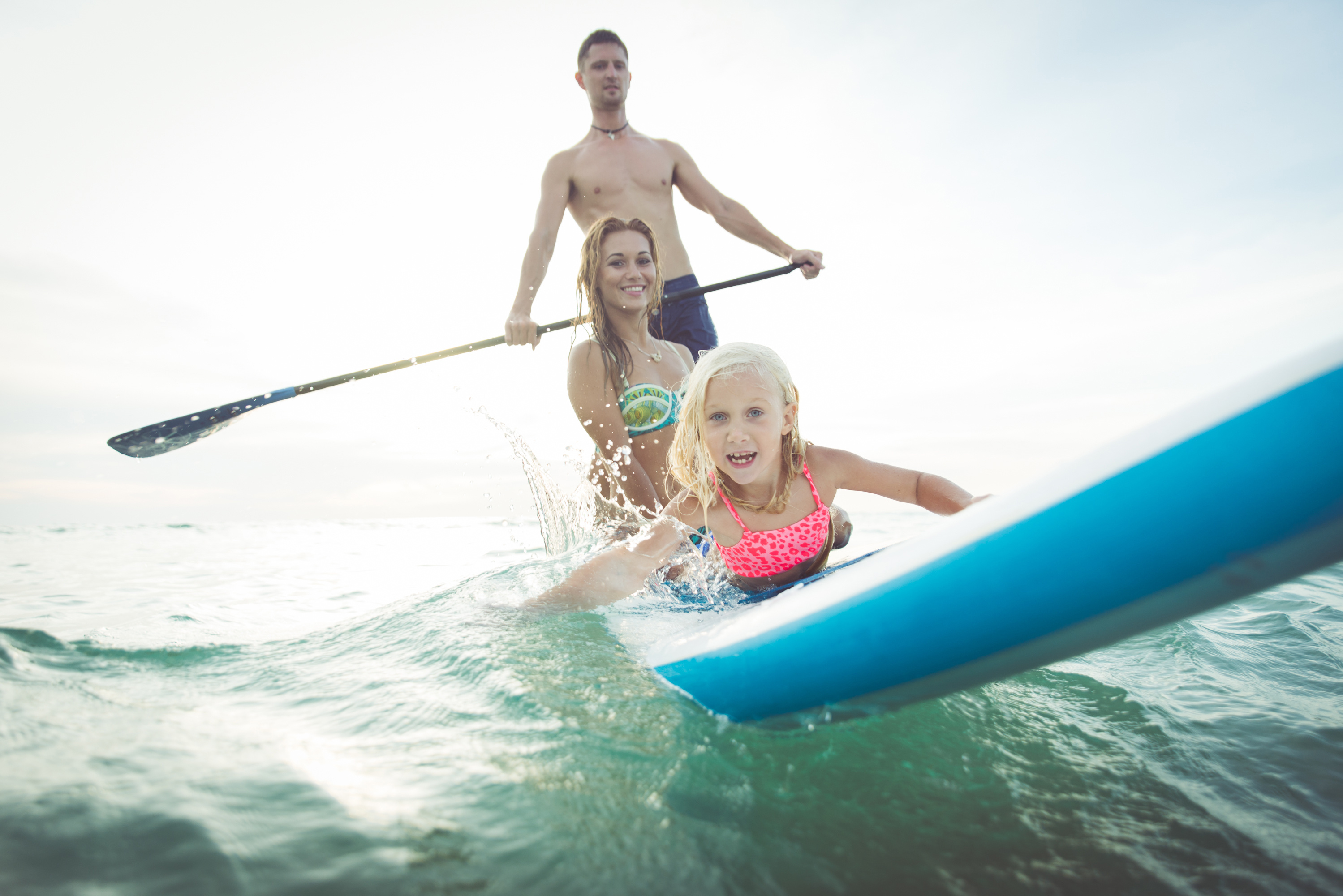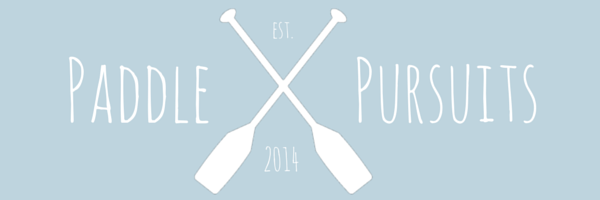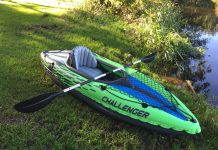
Stand Up Paddleboarding (SUP) is a new-ish sport that’s making a big splash. A mix between kayaking and surfing, SUP riders stand on their board like traditional surfers, but also use a paddle to manoeuvre the board.
Paddleboarding can be done anywhere. You can glide across calm lakes, explore rivers and other inland waterways, and you can catch waves at the beach.
The other big draw is the health benefits you get from taking part in a workout that is actually fun. Your legs and core muscles are under tension as they’re engaged when balancing, the arms and upper body muscles are used for paddling, and your cardiovascular system gets ramped up with increased exertion.
Paddleboarding starting to sound cool? Right about now, most people’s only question is; “how do I get started?”
Ask a paddleboarding veteran and you’ll most likely be greeted with surfer talk:
“Sup Dude. You wanna paddleboard? It’s easy bro, become one with the board and feel the water.” – not helpful.
If you’re looking for something a little more concrete, our post will teach you how to paddle board in a language you can actually understand.
Preparing for Your First Lesson
Some of these things are obvious, but it’s best we cover everything, so you don’t turn up to your first day at SUP school completely unprepared. If you’ve booked a lesson, your instructor will more than likely send you pre-course information covering all the below points.
- Dress for the occasion. This might mean a wetsuit if you live in a cold climate. If you have warm weather conditions, swimming shorts and a t-shirt is fine (or something to cover your shoulders), along with sunscreen and a hat to protect from the sun.
- Bring a towel and change of clothes. There’s a high probability that you’re going to fall off your board when learning. A change of clothes will ensure the journey home isn’t completely miserable.
- Bring water. You could be out on the water for an hour or more and paddling is thirsty work. A small bottle of water held down by the bungees on the deck can be a godsend on a hot day.
Here are some other things you may want to think about bringing along for paddleboarding.

Infographic courtesy of towerpaddleboards.com
Getting Kitted Out
You don’t need a lot of equipment to enjoy paddleboarding; the only essential items are a board and paddle. These may be supplied if you’re training with an instructor or you may be able to rent them for a day – you’ll find someone able to help you get the right gear with both of these options.
If you’ve not got a helping hand nearby, don’t worry. Just follow the advice below, and you’ll be SUPing in no time at all.
Selecting a Paddle Board
Paddleboards come in a variety of styles so they can be used for different purposes. There are
- Beginner or recreational paddleboards
- Touring boards
- Racing boards
- And even inflatable SUPs
You’ll most likely start off with a beginner board. These boards are wider which make it easier to balance, and they also have more fins, which help with balancing and tracking (keeping the board traveling in a straight line).
Increased width does reduce speed and the ability to turn a little, yet the stability offered by beginner boards are is a good trade-off for newbies. You can always upgrade your paddle board once you can comfortably handle it and perhaps when you know a particular SUP niche activity you want to get into (racing, surfing, fishing, touring, or perhaps practicing yoga on your board).
Getting a Correctly Fitted Paddle
The twist and lock feature of adjustable SUP paddles make getting the right size paddle for your height a breeze.
To set the correct height; stand up, raise one arm straight above your head, and hold the paddle against your outstretched body with the other arm. Adjust the shaft until the paddle handle reaches your wrist, and then lock it in place.
Some Safety Considerations
Again, if you’re taking lessons, all the safety precautions of stand up paddleboarding will be covered by your instructor. Regardless, it’s never a bad idea to run through the basics:
- Wear a life jacket. Although not strictly required, you should opt to wear a life jacket if you’re not a strong swimmer or you’ll be paddling in waves and strong current.
- Be able to swim at least 50m. You should not be attempting any water sport without being able to swim at least 50 metres (and preferably 100m)
- If you fall off, throw your paddle away. Paddles are quite buoyant, and if you land on a paddle that’s floating on the water’s surface, be prepared for a painful fall.
Stances
Before we get into the actual technique for balancing and strokes, let’s quickly go through the two stances of paddle boarding.
Low Stance (aka safe stance)
This is when you’re paddling on your knees. It’s a reassuring starting position for first timers. Use it until you find your sense of balance, or when you need to rest your legs. Your knees should be about 1-2 inches from the edge of the board for maximum stability.
High Stance
This is the regular stance when you’re on your feet. Your feet should be near the edge of the board and pointing forwards – not like a penguin. Keep your knees slightly bent.
Standing Up Procedure
Going from low stance to high stance the first time can be tricky. However, follow these steps slowly, and you’ll get to your feet without going for a swim.
- Do a couple of forward strokes to build momentum. It may sound counterintuitive, but standing up and balancing is easier once you’re in motion.
- Starting from your knees, place the centre of the paddle in line with the centre of the paddleboard just in front of you.
- Place your hands over the paddle and apply pressure to keep the board steady.
- Slowly move your feet until they are where your knees were previously (at the centre of the paddleboard and 1-2 inches from the edge).
- Grab hold of your paddle and go from crouching to standing.
How to Paddle a SUP
Congratulations, by now you’re (hopefully) standing on your board and ready to take your first few strokes.
Before you begin, make sure you’re holding the paddle correctly. One hand should be on the end handle, and the other should be about half-way down the paddle. The blade should have the curve facing up, so it resembles a speed bump.
Before we get into the technique for the strokes, remember this one piece of advice; the whole blade must be beneath the water’s surface with every stroke. For efficient paddling, the blade needs to be submerged. Fairy strokes don’t get you anywhere.
Forward Stroke – to go forward, use long strokes from North to South, running close to the edge of the paddleboard. Alternate between left and right sides to keep going straight - you will have to change hands on the paddle to do so.
Turning Strokes – if you want to turn left or right, use wide arc strokes. They should look like a quarter circle from above and start at the top of the board and finish around the middle.
Pivoting 180° and 360° - If you want to turn on the spot, do two strokes to at the front of the paddle, and then two strokes at the back of the paddleboard but on the opposite side.
Paddle Board Tricks
By now, you’re probably getting pretty confident on your board, and you’ll know the basics of how to paddle a sup. But before you get too cocky, here are a couple of tricks to bring down that bravado a notch or two.
- Walking on Water – With small steps and with your feet at the edges, walk up and down to the front and back of the board.
- Rock the Boat – Alternate the pressure in your legs in a sort of cycling motion, so that the board rocks from side to side. Rocking the paddleboard from side to side mimics the action of a wave and is good for practicing balance in choppy conditions. If you’ve got an evil streak, you can also use this trick to make nearby paddlers fall off.
- 360 Wheelie – Move to the back of the paddleboard so that the front end sticks up out of the water. Paddle at one side to spin 360 in a tight circle.
- 180’s and 360’s – No sport would be complete without some cool spins. Jump up and spin 180 or 360 degrees. Then look around to see if anyone noticed how cool you are.
- Hang Ten – This is the classic surfer trick. Move as close to the front of the paddle board as possible, and then, as the name suggests, try to hang your toes over the edge of the paddleboard.
Bonus: How to Paddle Board Video
If you want to learn the above paddle boarding lessons in visual format, check out this video.
Conclusion
Now you know the fundamentals of stand up paddle boarding, it’s time to put them to use. As you do, be mindful that there are going to be times when you fall off, look stupid, and feel foolish. Don’t let it bother you. It’s simply part of the learning process.
Get back on your board and practice some more. Pretty soon you’ll be a SUP veteran with a fit and healthy body, and you’ll be posting pictures of all the cool new places your paddling on Facebook – much to the envy of your friends.
As an Amazon Associate, we earn from qualifying purchases. This is without any additional costs for the buyer but does support us in maintaining our website.



